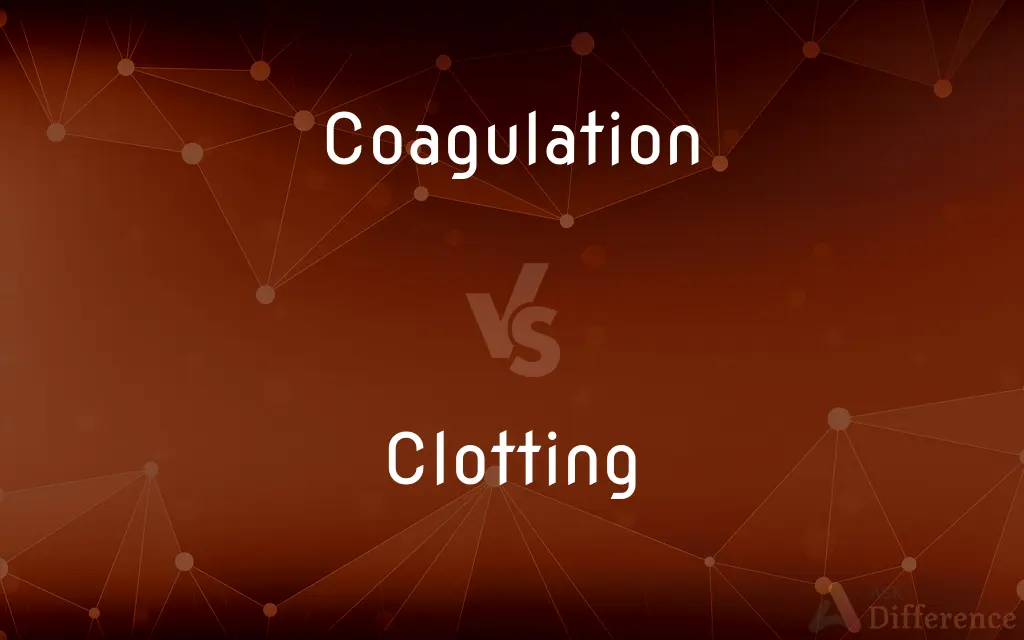Coagulation vs. Clotting — What's the Difference?
By Maham Liaqat & Urooj Arif — Updated on March 29, 2024
Coagulation is the overall process involving a cascade of events leading to blood clot formation, whereas clotting specifically refers to the final stage where blood transforms from liquid to gel, forming a clot.

Difference Between Coagulation and Clotting
Table of Contents
ADVERTISEMENT
Key Differences
Coagulation is a complex process that involves multiple steps, including the activation of clotting factors, leading to the formation of a blood clot. It's an intricate sequence of events initiated by signals from a damaged blood vessel. On the other hand, clotting is the end point of the coagulation process, where fibrin threads form a mesh that traps blood cells, effectively sealing the site of injury.
The coagulation process is divided into three main phases: the vascular phase, the platelet phase, and the coagulation phase, which culminates in clotting. Whereas clotting itself is part of the coagulation phase, highlighting the transition of blood from a liquid to a solid state to prevent excessive bleeding.
Coagulation involves not only the formation of a blood clot but also its stabilization and eventual dissolution, a process known as fibrinolysis. On the other hand, clotting focuses narrowly on the actual formation of the clot, without addressing the broader aspects of its regulation or removal.
While both terms are often used interchangeably in everyday language, their distinction is crucial in medical and scientific contexts. Coagulation refers to the entire process, encompassing various biochemical reactions, while clotting is specifically the act of forming the clot.
In understanding disorders related to blood, distinguishing between coagulation and clotting becomes significant. Disorders of coagulation can affect any part of the process and have a wide range of causes and effects, whereas clotting disorders specifically impact the ability of blood to solidify and form a stable clot.
ADVERTISEMENT
Comparison Chart
Definition
The process involving a series of events leading to blood clot formation.
The final stage of coagulation where blood solidifies.
Phases
Vascular, platelet, and coagulation phases.
Part of the coagulation phase.
Focus
Entire process, including clot formation, stabilization, and dissolution.
Specifically the formation of a clot.
Scope
Broad, covering multiple steps and reactions.
Narrow, focused on the end result of coagulation.
Medical Significance
Involves understanding the entire clotting mechanism and its disorders.
Specifically related to the blood's ability to form a clot.
Compare with Definitions
Coagulation
Regulated by a cascade of reactions.
The coagulation cascade activates enzymes that lead to clot formation.
Clotting
Can lead to thrombosis if abnormal.
Excessive clotting in blood vessels can cause dangerous blockages.
Coagulation
Can be affected by various disorders.
Hemophilia is a disorder that affects the coagulation process.
Clotting
Forms a fibrin mesh to trap blood cells.
During clotting, fibrin strands weave together to stop bleeding.
Coagulation
A comprehensive process leading to blood clot formation.
Coagulation involves several clotting factors working in sequence.
Clotting
Can be visualized as blood gels.
You can see clotting when a drop of blood solidifies outside the body.
Coagulation
Involves both clot formation and dissolution.
After the wound heals, coagulation ensures the clot is dissolved.
Clotting
The final step in blood coagulation.
Clotting seals the wound by forming a solid mass of blood cells.
Coagulation
Essential for stopping bleeding.
The coagulation process is vital for preventing blood loss after injury.
Clotting
Necessary for wound healing.
Clotting at the site of injury prevents infections by closing the wound.
Coagulation
Coagulation, also known as clotting, is the process by which blood changes from a liquid to a gel, forming a blood clot. It potentially results in hemostasis, the cessation of blood loss from a damaged vessel, followed by repair.
Clotting
A thick, viscous, or coagulated mass or lump, as of blood.
Coagulation
To cause transformation of (a liquid or sol, for example) into or as if into a soft, semisolid, or solid mass.
Clotting
A clump, mass, or lump, as of clay.
Coagulation
To become coagulated
As it cooled, the sauce began to coagulate.
Clotting
A compact group
A clot of trucks blocking the tunnel's entrance.
Coagulation
The precipitation of suspended particles as they increase in size (by any of several physical or chemical processes)(e.g. of proteins)
Clotting
To form into a clot or clots; coagulate
The blood clotted over the wound.
Coagulation
The process by which blood forms solid clots.
Clotting
To cause to form into a clot or clots.
Coagulation
Similar solidification of other materials (e.g. of tofu).
Clotting
To fill or cover with or as if with clots.
Coagulation
The change from a liquid to a thickened, curdlike, insoluble state, not by evaporation, but by some kind of chemical reaction; as, the spontaneous coagulation of freshly drawn blood; the coagulation of milk by rennet, or acid, and the coagulation of egg albumin by heat. Coagulation is generally the change of an albuminous body into an insoluble modification.
Clotting
Present participle of clot
Coagulation
The substance or body formed by coagulation.
Clotting
Clotted material.
Coagulation
The process of forming semisolid lumps in a liquid
Clotting
The process of forming semisolid lumps in a liquid
Common Curiosities
What is the role of platelets in coagulation?
Platelets play a crucial role in coagulation by adhering to the site of a blood vessel injury and forming a plug, which is then reinforced by the clotting process.
Can clotting occur without coagulation?
Clotting is a part of the coagulation process and cannot occur independently; it is the culmination of the coagulation cascade.
What is the difference between coagulation and clotting?
Coagulation refers to the entire process of blood clot formation, including various phases and reactions, whereas clotting specifically describes the final act of blood solidifying to form a clot.
What is fibrinolysis?
Fibrinolysis is the process of breaking down the fibrin clot once it has served its purpose of stopping bleeding, ensuring blood vessels remain open.
How is coagulation initiated?
Coagulation is initiated by damage to a blood vessel, triggering the coagulation cascade involving various clotting factors.
What are common coagulation tests?
Common coagulation tests include prothrombin time (PT) and activated partial thromboplastin time (aPTT), which assess the blood's ability to clot.
Are coagulation disorders the same as clotting disorders?
Coagulation disorders can affect any part of the coagulation process and have broader implications, while clotting disorders specifically affect the ability to form a clot.
What triggers the clotting mechanism?
The clotting mechanism is triggered by the exposure of blood to substances outside the blood vessels or to damage within the vessel wall.
Can lifestyle affect coagulation?
Yes, lifestyle factors such as diet, exercise, and smoking can affect coagulation, influencing the risk of clotting disorders and cardiovascular diseases.
Are there genetic factors influencing coagulation?
Yes, genetic factors can significantly influence coagulation, with certain genes affecting the risk of bleeding or clotting disorders.
How can clotting disorders be treated?
Clotting disorders may be treated with medications that either promote clotting in cases of bleeding disorders or prevent clotting in cases of excessive clot formation.
Can coagulation be artificially induced?
Yes, coagulation can be artificially induced using medications or treatments in individuals with bleeding disorders or during surgical procedures to prevent excessive bleeding.
How do anticoagulants work?
Anticoagulants work by interrupting the coagulation cascade, thereby reducing the formation of blood clots.
Is coagulation the same in all animals?
While coagulation is a common biological process across many animals, the specific factors and mechanisms can vary between species.
What is the significance of the coagulation cascade?
The coagulation cascade is significant because it ensures a rapid and targeted response to vessel injury, preventing excessive blood loss while minimizing the risk of unwanted clot formation.
Share Your Discovery

Previous Comparison
Loud vs. Quiet
Next Comparison
Mimicry vs. CamouflageAuthor Spotlight
Written by
Maham LiaqatCo-written by
Urooj ArifUrooj is a skilled content writer at Ask Difference, known for her exceptional ability to simplify complex topics into engaging and informative content. With a passion for research and a flair for clear, concise writing, she consistently delivers articles that resonate with our diverse audience.
















































